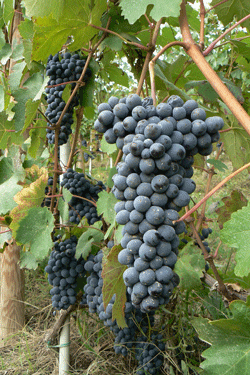text and photos ©2006
Though Barbera is among the top tier of wine grape varieties in terms of quality, it receives very little attention from either the wine press or wine consumers. Not that it isn’t widely planted; it’s just unappreciated. In California, where 10,000 acres are planted mainly in the Central Valley, it has been largely and anonymously relegated to jug wines, while in its birthplace, Italy’s Piemonte where it covers 35% of the area’s 143,000 acres, it has always has played second fiddle to Barolo and Barbaresco, wines made from the Nebbiolo grape. There Barbera is considered the locals’ everyday wine.

Barbera grapes
Yet properly grown and vinified, Barbera has several advantages over its more illustrious cousins. While Barolo can age into an elegant and even delicate wine, in its youth it is preposterously tannic. Few people today have the patience to age a wine 10 or 15 years, and the flavors one derives from bottle ageing are unappreciated by most consumers. In today’s world the consumer wants to enjoy a wine the day he or she buys it, and the more fruit flavor the better. Barbera can now step to the head of the class.
Barbera has lush fruit in the plum and cherry vein, often accented by mocha, pepper and spice. Its naturally high acidity makes it food-friendly, and makes it well suited to this current era when very ripe grapes are in vogue. So let’s take a look at the different Barberas available from Piemonte (Piedmont).
Denominazione Origine Controllata (D.O.C.)
Denominazione Origine Controllata means simply “place of origin controlled,” and refers to laws that have been put in place controlling not only the delimited area that can produce a particular wine, but also some of the growing and vinification practices affecting those wines.
The Barbera area is east and south of Torino, in northern Italy. The broader region is known as Piemonte (foot of the mountains). It’s notable for its rolling hills, hilltop towns, castles, and steep hillside vineyards. Due to the endless variations of exposure and elevation, each small plot of land has its own very special microclimate.
The Barbera Monferrato is the largest zone encompassing all of Barbera d’Asti, as well. Within the Barbera d’Asti zone are three sub-regions, Nizza, Colli Astiani, and Tinella. Barbera d’Alba is separate and contiguous to Barbera D’Asti. Barbera Colli Tortonesi is separate, a few miles east of the edge of the Monferrato zone. All of this may be confusing, but it’s enough for the consumer to remember that Barbera comes from Piemonte, an area just east and south of Torino, in the rolling foothills of the alps.
A Barbera sporting the Superiore title must be aged at least one year, during which it must spend at least 6 months in wood. It must not be released until January 1st , two years after the harvest.
Current Vintages
I recently attended a week long tasting in Asti where we formally blind-tasted 202 wines from recent vintages. My broad assessment of the currently available vintages is as follows:
Barbera D’Asti:
2001: The 2001 vintage was mixed in quality, and most were released two or three years ago. The 2001s afforded us at this tasting were atypical but very complex wines that have pronounced herbal-vegetal-earthy overtones that were not very apparent in the 2001s we tasted in 2004. If this bunch is any indication, they are ageing quickly and should be drunk within the next five years.
2002: This was a disastrous vintage, plagued by hail and rain. The few presented in this tasting were of poor quality. However, of the 2002s I’d tasted previously, four were notably very good: Pico Maccario’s Lavignone vineyard, Marchesi Alfieri’s La Tota vineyard, Isabella’s Bricco Montema, and Agostino Pavia’s Moliss Vineyard.
2003: The difficult and very warm 2003 vintage produced some complex, balanced wines showing very ripe fruit and spices, but the Superiore versions were overly extracted, tannic and alcoholic. The best of the vintage came from the Nizza sub-region. These Barbera D’Asti Superiore Nizza were marked by a uniformly silky texture, fine balance and very little of the over-ripe, overly alcoholic character seen in other districts in 2003.
2004: Problems encountered with the 2004 vintage had more to do with winemaking, such as stuck fermentations, unintentional secondary fermentations in the bottle, and thoroughly disjointed wines. Yet 2004 did produce some complex, balanced wines with vibrant acidity and soft tannins. The best wines this year were in the Superiore category, with the better producers offering fruity, floral, complex and elegant wines.
2005: The few 2005s that have been bottled show tart acidity, good concentration of fruit, and balance.
Barbera del Monferrato:
2003: The 2003 vintage produced wines that were over-ripe, extracted, simple, hot and tannic.
2004: There was nothing wrong with the grapes in 2004, but the quality is spotty due to some winemaking mistakes. The best wines are in the Superiore category.
Barbera D’Alba:
2003 showed over-ripe grapes that were extracted, tannic and hot, and ultimately simple.
2004 showed some winemaking errors and generally high acid.
Barbera Colli Tortonesi:
2003: The 2003s were monolithic and disjointed.
2004: The 2004s were a mixed bag with some complex, balanced wines and some clinkers.

Vineyards cover the lower slopes of many hilltop towns in Piedmont
92 points, Vignetti Massa 2005, Sentieri, Colli Tortonesi Barbara:
Sweet plummy fruit with layers of dark chocolate, nutmeg and pepper, fine structure, velvety texture and long finish. Good ageing potential.
92 points, Tenuta Garetto 2005, Tra Neuit e Di, Barbera D’Asti:
Uncommonly well balanced. Red Bell pepper and gunpowder nuances over mouth coating blackberry fruit with some spicy complexity, velvety texture and good length. Despite its ripeness, it retains firm acidity.
91 points, Villa Giada 2004, Vigneto La Quercia, Barbera D’Asti Superiore:
Round and supple, showing perfectly integrated oak and a depth of blueberry-plum fruit with a hint of licorice and vanilla. Very elegant in its youth, with the structure to age a few years. Villa Giada also showed well two years ago when we tasted the newly released 2001 vintage.
91 points, Bricco Mondalino 2001, Gaudium, Barbera del Monferrato:
Tasted from a magnum, this wine tastes 10 years older than it is. It offers up a simple berry fruit core, surrounded by fennel, dried herbs and dead leaf overtones that give it complexity. It’s unlikely to improve, so drink it now.
90 points, La Ghersa 2004, Camparo, Barbera D’Asti Superiore:
Dark ruby color, high sweet floral aroma (camilias-violets), very elegant on the palate, with dark cherry-blueberry fruit and a hint of forest floor complexity that reminds me of Pinot Noir. The silky smooth texture and medium-light body are also reminiscent of Pinot. The floral note leads me to believe Nebbiolo is in the blend, which works wonders here.
90 points, Villa Giada 2004, Bricco Dani, Barbera D’Asti, Nizza Superiore:
The Villa Giada has lots of oak, but it’s balanced by a like amount of deep blueberry and plum fruit. Full-bodied, with soft tannins, the oak adds sweet spices on the palate (cinnamon, nutmeg, vanilla), as well as licorice. This a complex and powerful wine with plenty of potential.
90 points, Tenute Cisa Asinari Dei Marchesi di Gresy 2003, Monte Colombo, Barbera D’Asti:
Supple and oaky, but plenty of sweet strawberry-plum fruit to match. The oak adds nutmeg and cinnamon notes, and the bright acidity carries the finish for minutes. Excellent ageing potential.
90 points, Ivaldi Dario 2004, Piccona, Barbera D’Asti:
Well-balanced, concentrated wine with plummy fruit, spicy overtones and a hint of forest floor complexity. It’s medium-bodied, with soft tannins. The finish is extraordinarily long
90 points, Coppo 2004, Pomorosso, Barbera D’Asti:
A seamless blend of plum, mocha, toast, vanilla and earth. Vibrant and harmonious from nose to finish. One taster suggested it was Californian in style, but I beg to differ; it’s a ripe, international style of wine, but it remains Piemontese at heart. Coppo is one of Piedmont’s most consistent producers.
90 points, Vecchia Cantina Sociale di Alice Bel Colle e Sessame D’Asti 2004, Barbera D’Asti:
Quintessential Barbera. Medium-bodied, silky (yet showing vibrant acidity), plum, strawberry and dead leaves, powerful but restrained.
90 points, Cossetti 2004, Venti di Marzo, Barbera D’Asti:
Very good typicity, with plum and cherry cobbler flavors, full body, moderate tannin, and an aromatic finish of great length.
90 points, Terralba 2004, Identita, Colli Tortonesi Barbera:
The wine is built on a core of plummy fruit surrounded by earth, mineral and orange peel aromas and flavors. Somewhat silky, it shows a firm structure, moderate tannin, excellent balance, and an extremely long finish.
89 points, Oddero 2004, Vinchio e Vaglio Serra, Barbera D’Alba:Oddero has been steadily improving over the past 10 years, as a producer of Barbera, Barolo and Barbaresco. This offering is deep purple, with a vibrant cherry-plum-floral aroma, medium body, silky texture, and long spicy finish. The floral component suggests a little Nebbiolo in the blend.
89 points, Baravalle 2003, Barbera D’Asti, Nizza Superiore:
Cinnamon bark, rhubarb pie, pepper and plums with soft tannin and a fruity-mineral finish. Winemaking magic.
89 points, Cantina di Nizza 2003, Ceppi Vecchi, Barbera D’Asti, Nizza Superiore:
Tart cherry aroma and flavors with milk chocolate and cinnamon accents on the palate. Fine concentration of flavors, soft tannin, crisp acidity and good length.
89 points, Tenuta La Fiammenga 2003, Paion, Barbera D’Asti Superiore:
A very supple, engaging wine with vibrant acidity, sweet tannins and subtle minerality that surrounds a core of cherry and plum fruit. Fine long finish. A great find. One of the few really good 2003 Superiores.
89 points, Dino Mutti 2003, S. Ruffino, Colli Tortonesi Barbera:
A big, powerful, extracted wine showing jammy, spicy plums and good balance of oak to fruit. It’s big, yet there is still some elegance, and it should improve over the next 5 to 10 years.
89 points, Cantamessa 2004, San VI, Barbera D’Asti:
Deep forest floor-earthy aromas with a core of strawberry fruit and jasmine, tart acidity and long strawberry finish. The description might fit a Pinot Noir, but it really has very good varietal definition. This is a lighter style, elegant wine with some complexity.
89 points, Cantine Valpane 2004, Rosso Pietro, Barbera del Monferrato:
This is a somewhat atypical but very good Barbera, with violet, camillia, and strawberry pie aromas and flavors, it seems more like Pinot Noir, but the structure says Barbera. When I encounter a Barbera like this (about 5% of Italian Barberas fit this description), I assume some Nebbiolo or Dolcetto has been included in the blend. Regardless, it’s a very attractive wine that is worth searching for.
89 points, Vietti 2003, La Crena, Barbera D’Asti, Nizza Superiore:
Ripe plum and blackberry flavors give this wine a sweet impression, though it is dry on the palate. Soft tannin makes it drinkable now. Bracing acidity gives it a lift in the finish and guarantees it will work well at the dinner table.
89 points, Cascina Marcantonio 2001, Barbera D’Asti:
A very complex and complete wine with a nose like chocolate mint on top and mushrooms beneath, with a base of sweet plums and an herbal-fruity finish of some length. Drink now.
88 points, Caudrina 2004, La Solista, Barbera D’Asti:
A bit over-ripe, the pruney flavors are saved by a light floral edge. This is a full-bodied, mouthcoating wine with soft tannin. Perfect for steak or barbeque.
88 points, Gozzelino 2003, Lorenzo Gozzelino, Barbera D’Asti Superiore:
Nice earthy-tobacco notes and noticeable oak, but in balance with the supple, ripe cherry-berry fruit and a hint of vanilla. Crisp and stylish.
To learn more about the ratings click here.
& & &
